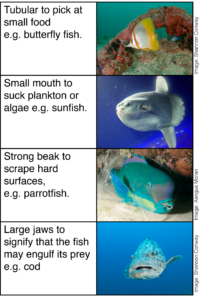Back to: ZOOLOGY 300 Level
WELCOME TO CLASS!
I’m truly glad to have you back again today. You’re doing excellently, and your dedication is shining through. Today, we’re going to understand something really interesting and practical—the differences in how animals adapt to living in freshwater (like rivers and lakes) versus marine environments (like seas and oceans).
Freshwater Vs. Marine Adaptations
Think about it: a tilapia in a Nigerian river and a snapper in the Atlantic Ocean face very different challenges, even though they both live in water. The secret behind their survival? Adaptations—unique features that help them cope with their surroundings. Let’s take a closer look.

Understanding the Environment
First, let’s define the two:
- Freshwater environments include rivers, streams, lakes, and ponds. The water here has low salt content.
- Marine environments include seas and oceans, which have high salt content (salinity).
These differences in salinity create different challenges for animals, especially with osmoregulation—the process of balancing water and salt inside the body.
Osmoregulation in Freshwater Animals
Animals in freshwater constantly gain water through osmosis, because their body fluids are saltier than the surrounding water. To survive:
- They don’t drink water, unlike marine animals.
- Their kidneys excrete large volumes of dilute urine to remove excess water.
- Their gills actively absorb essential salts and ions from the environment.
- Many have thin, permeable skins to allow gas and salt exchange.
An example is the African catfish (Clarias gariepinus), common in Nigerian freshwater ponds. It survives by excreting lots of urine and absorbing needed salts through its gills and skin.
Osmoregulation in Marine Animals
In contrast, marine animals are surrounded by salty water, which causes them to lose water and gain excess salt.
- They constantly drink seawater to replace lost fluids.
- Their gills and kidneys work hard to excrete excess salt.
- They produce small amounts of concentrated urine to conserve water.
For instance, the Atlantic mackerel in Nigerian coastal waters must deal with salt gain by pushing it out through special salt-excreting cells in their gills.
Sharks and rays are a bit different—they retain urea in their bodies to maintain internal salt levels close to seawater, reducing water loss.
Reproductive Adaptations
Freshwater animals often lay fewer, larger eggs with protective coatings due to unstable conditions (e.g., flooding, drying).
Marine animals usually produce many tiny eggs, relying on sheer numbers for survival due to predators and dispersal in open waters.
For example, freshwater tilapia may guard their eggs in nests or even mouth-brood, while marine codfish may lay millions of eggs into open water.
Behavioural Adaptations
- Some fish migrate between the two habitats:
- Anadromous fish (like salmon) are born in freshwater, live in the sea, and return to freshwater to spawn.
- Catadromous fish (like eels) do the opposite.

Although rare in West Africa, understanding such migrations helps explain biodiversity in global fish populations.
Summary
- Freshwater and marine animals face opposite challenges: freshwater animals deal with too much water, marine animals with too much salt.
- Their kidneys, gills, and behaviours are specially adapted for survival.
- Reproductive strategies and body structures also differ to match the environment.
Evaluation
- Why do freshwater fish excrete large amounts of urine?
- How do marine fish prevent dehydration?
- Give one structural difference between freshwater and marine fish.
- What is the difference between anadromous and catadromous fish?
- Why do marine fish tend to produce more eggs than freshwater fish?
You’ve done well in understanding how nature has beautifully equipped animals to survive in very different kinds of water. These adaptations remind us that survival depends not just on strength, but on how well an animal fits its environment. Keep growing—we’ve got more exciting lessons ahead!
